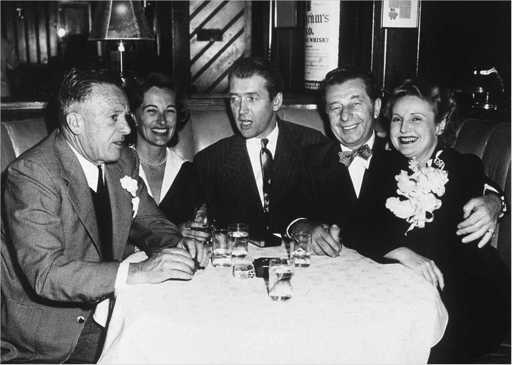You Must Remember This (29 page)
Read You Must Remember This Online
Authors: Robert J. Wagner

The restaurant was called Romanoff’s on the Rocks because it was literally built into the rocks by Highway 111, just before you got to La Quinta. Mike gave the new place a lavish publicity send-off, but it failed. And that wasn’t the worst of it: on New Year’s Day 1962, he closed his signature restaurant on Rodeo Drive.
A day or so later Billy Wilder called Kurt, Romanoff’s longtime maître d’, and offered to support him in building his own
restaurant, backed up by a group of other regulars—Jack Benny, Otto Preminger, and Jack Warner. Kurt opened the Bistro on Canon Drive, which thrived for years, and where he also served the individual chocolate soufflés.
So Romanoff’s lived on, after a fashion. Unfortunately, Mike didn’t. When his time came, Mike was in the hospital, being attended by his wife Gloria. Some doctors entered his room, looked at his charts, felt his pulse, mumbled something vague, and left. After they were gone, Mike said, “Chicken fuckers, all of them.” He turned to Gloria and said, “Not you, my darling.” And then he died.
Great last words.

I loved Romanoff’s, and I loved Mike, but for me, judged strictly by the food, Chasen’s was the best.
Why? Because Dave Chasen and his wife ran that place like a Swiss clock. Dave Chasen had been a vaudevillian, a dancer, a show business professional. His high point had probably been working as second banana to Joe Cook in
Fine and Dandy
in 1930, the first Broadway musical hit to have a score written by a woman, Kay Swift.
Dave’s forte onstage was silence. He didn’t speak, but became known for something called the “Idiot’s Salute,” which began with the sudden raising of both arms to his chin, as if to fend off a punch. As Frank Capra described it: “Then a sudden expression change from mock fright to the widest-eyed, most open-mouthed gargoylish smile ever seen on any face, followed by the right hand—fingers spread wide and palm toward viewer—crossed in front of his fixed idiot’s smile like a slowly opening fan.”
Dave was born in Odessa, Ukraine, and came to America when
he was still a toddler. He even appeared in a couple of movies in the early days of sound—
Rain or Shine
and
Old Man Rhythm.
When things slowed up in his acting career, Dave opened Chasen’s in 1936 with the financial backing of Harold Ross of
The New Yorker
. Ross’s investment was three thousand dollars, and he was going strictly on the fact that he liked Chasen and had fond memories of the meals that Chasen had prepared for friends back in New York.
Chasen’s started out as a glorified barbecue joint—the original name was Chasen’s Southern Pit Barbecue—located on Beverly Boulevard, near Doheny. At this point Chasen’s had six tables, a counter that seated eight, and a bar that sat six. The chili was twenty-five cents a bowl, the ribs thirty-five cents.
As soon as word got around, everybody who had known Dave, or eaten his food back east, began beating down the door. Within a year, Chasen’s Southern Pit Barbecue had been transformed into a full-service restaurant. The menu underwent a serious expansion to more than thirty items, and Dave added a room with a couple of dozen tables. The staff grew from a total of three to dozens.
The mood at Chasen’s was never particularly glamorous, but it was comfortable, clubby. Dave had very specific ways of doing things. For instance, Chasen’s was the first restaurant I knew to have crushed ice in the urinals.
The regulars included W. C. Fields, Gene Fowler, Frank Capra, Nunnally Johnson, and, somewhat later, yours truly. Chasen’s was my favorite restaurant from the time I was seven years old, when my father took me there shortly after we arrived in town. I loved the environment: dark wood, red leather booths, the pictures of celebrities on the walls. Then there were Pepe the bartender and Pierre the maître d’, who made me feel part of the Chasen’s family.
But mostly there was Dave and Maude Chasen. Dave was a small man, very energetic, and he had some of the comic’s intrinsic manner—very upbeat, always with a joke—but he wasn’t overbearing about it, as so many comics are.
Both he and Maude were attentive hosts who would walk around greeting the customers, and not just the celebrities. Their attitude was that if you had the good sense to eat at Chasen’s, then you were as much a celebrity as any of the stars. That said, there were no walk-ins; you had to have a reservation. And Dave absolutely forbade autograph hunters, photographers, and gossip columnists. That’s one of the reasons the patrons felt so relaxed—there was no possibility of saying or doing anything that would get in the papers.
Sometimes people would get up and do impromptu routines. Ray Bolger might perform one of his glorious eccentric dances, or Jimmy Cagney might sing a song entirely in Yiddish—he was fluent. Dave’s best friend was probably Billy Grady, an old vaudeville chum who became head of casting at MGM, and therefore a very important personage. Grady had a special booth and was there most nights.
If Dave loved you, the restaurant was yours. When Dorothy Lamour was pregnant, she complained to Dave that she wasn’t comfortable at Table 12 anymore, so he had a portion of the table sawed away to make room for her expanding stomach.
For Jimmy Stewart’s bachelor party, Dave hired a valet to shadow Jimmy throughout the night. The valet fed him, wiped his chin, escorted him to the bathroom, and, for all I know, raised and lowered his zipper for him. Two midgets dressed in diapers were served on a silver platter. Bob Hope once rode a horse through the restaurant—I’ll bet it was on a dare—and the character actor Charlie Butterworth once drove his Fiat into the place.
Dave once told me that Chasen’s invented the Shirley Temple. It seems that Shirley and her parents were eating there when the little star got restless because her parents were drinking and she wanted to drink, too. The bartender threw together some grenadine, ginger ale, and some fruit, and served it to Fox’s biggest star. Voilà!

The good life and good people at Chasen’s. From left, Billy Grady, head of talent at MGM; Gloria Stewart; Jimmy Stewart; and Dave and Maude Chasen.
Getty Images
By the time I was going to Chasen’s regularly, Dave had added a sauna and a barber at the rear of the place, and there was also a Ping-Pong table—Clark Gable and Gary Cooper were regular players, as were W. C. Fields and Gregory La Cava. There was also a steam room on the second floor, and the men’s room was furnished with reading lamps so that you could pass the time with the newspapers and magazines while you were answering nature’s call.
By that time, the barbecue, which had always been Dave’s special passion, had also been relegated to the rear of the building. But the food! Chasen’s became famous for its legendary chili, but there
was also Dave’s hobo steak, which was cooked between inch-thick slabs of salt. Dave told me that he had learned the recipe from another comic in his vaudeville days, who had gotten the recipe from an actual hobo, which is why Dave called it the hobo steak. And then there was the cheese toast, and the fresh seafood served on pyramids of ice, and great desserts—strawberry shortcake, wonderful apple pie. And I particularly remember the banana shortcake with chocolate sauce.
When Dave died in 1973, Jimmy Stewart was on location, but he left the movie and came back to Los Angeles to deliver the eulogy. Frankly, anybody who knew Dave would have done the same. After Dave’s death, Maude kept the restaurant going for a long time, but eventually it got too hard to keep it up. When the place finally closed in 1995, a friend of mine bought the picture of me that Dave had kept in his office, and gave it to me.
I still have that picture. That, and my memories of Dave, Maude, their wonderful food, and, most important, their friendship.
Along with Chasen’s, Natalie’s and my favorite restaurant was La Scala, which was run by Jean Leon, who got the seed money from a tip given him by Frank Sinatra. Jean ran a superb eating establishment, but his real passion was wine—his ambition was to have his own vineyard, which he eventually realized. Not surprisingly, Jean’s wine was as good as his food. As with Chasen’s, La Scala was a no-press zone; there were never any stories in the paper about who had eaten there the night before.
Jean proved his friendship for me a hundred times, not just emotionally, but financially. When jobs were scarce and I was having trouble making ends meet, Jean ran a tab and carried me. Years later, when my life and career had both turned around, Natalie and I invested in a new venture of Jean’s, Au Petit Jean, along with the director George Stevens—a good man, if a trifle remote. Au Petit Jean was successful for a while, and then it wasn’t. Finally, it closed. But as far as I’m concerned, Jean Leon was much more than a great restaurateur; he was a great friend.

Restaurateurs David Chasen and Mike Romanoff with Humphrey Bogart during a Christmas Eve party at Bogart’s house in Beverly Hills.
Getty Images

Another legendary restaurant was in the Ambassador Hotel on Wilshire Boulevard. The hotel itself opened in 1921, on the site of a dairy farm on top of a small hill. At the time, there wasn’t a whole lot else on Wilshire. The hotel’s original purpose was as an all-inclusive winter resort for Eastern and Midwestern families who wanted to escape the cold, much like the Breakers in Palm Beach, which opened a few years later. The resort had more than twenty acres, and featured riding trails, golf courses, and views of the
mountains and of the ocean. The Ambassador had a great clientele, because Hollywood didn’t really have another first-class hotel until late in the 1920s. Scott and Zelda Fitzgerald and Winston Churchill all stayed there.
Within the Ambassador was the famous Cocoanut Grove, which seated a thousand and was decorated with artificial palm trees supposedly recycled from the set of Valentino’s movie
The Sheik
. The story goes that the Grove had a maître d’ named Jimmy Manos, who was a friend of Valentino’s, which enabled the Grove to get the palms for little more than the cost of trucking them away. Over the years the place added papier-mâché coconuts and toy monkeys whose eyes lit up.
It sounds like an outlandish urban legend, but it’s tragically true. The first time I went to the Grove, I spent most of the evening craning my neck looking at the monkeys.